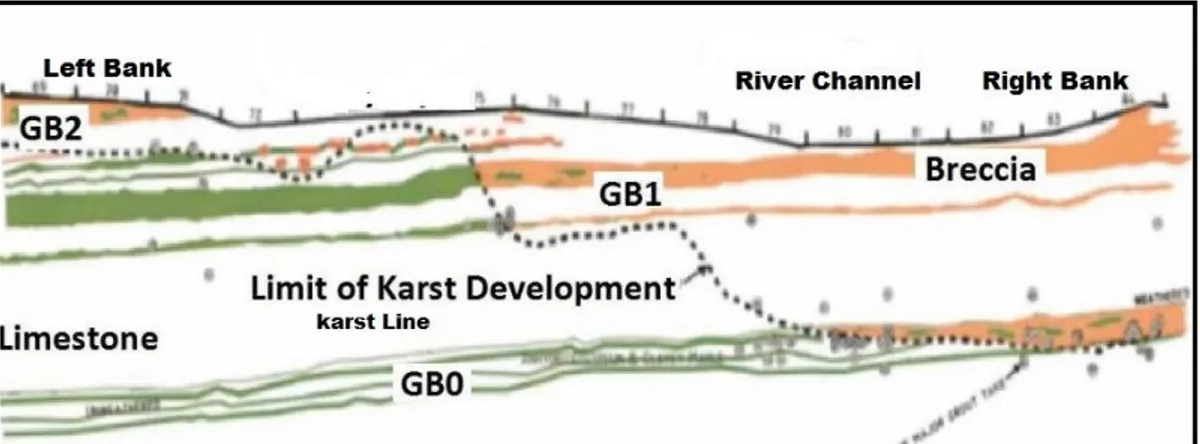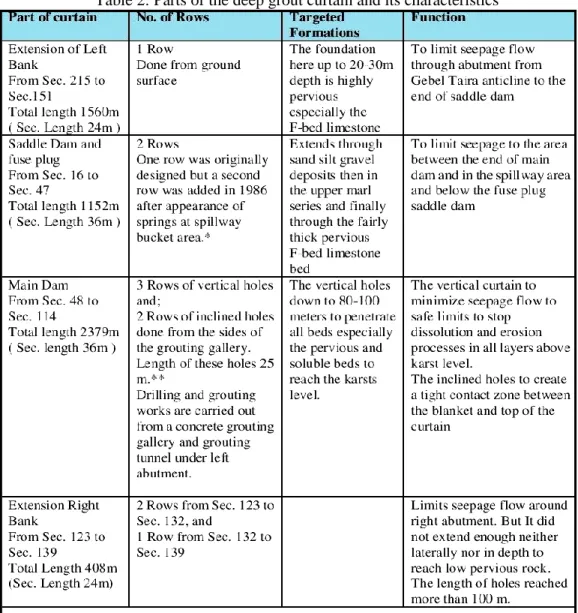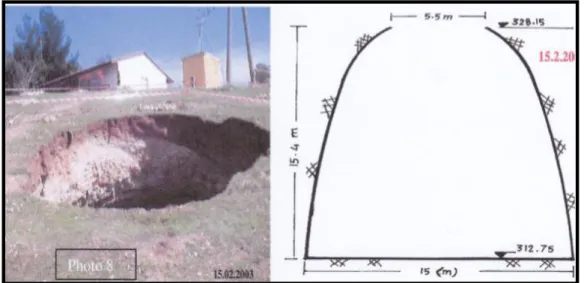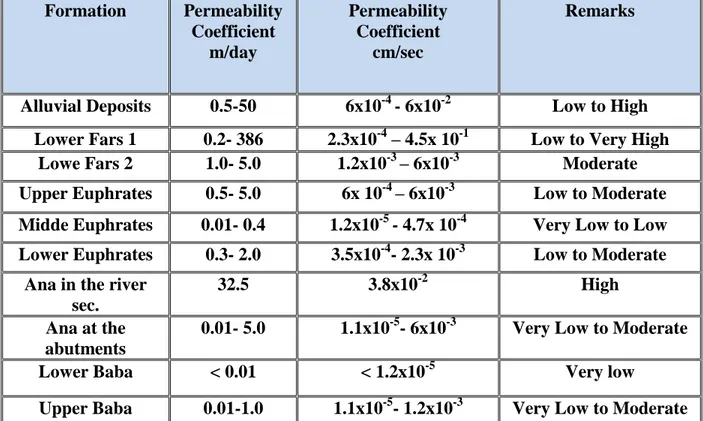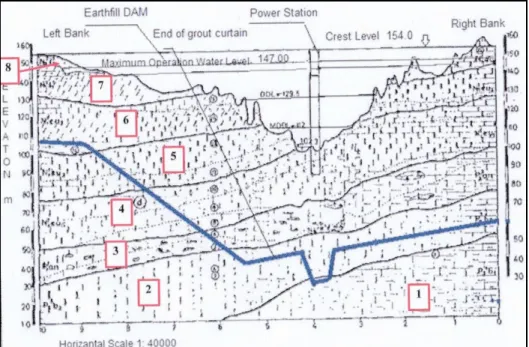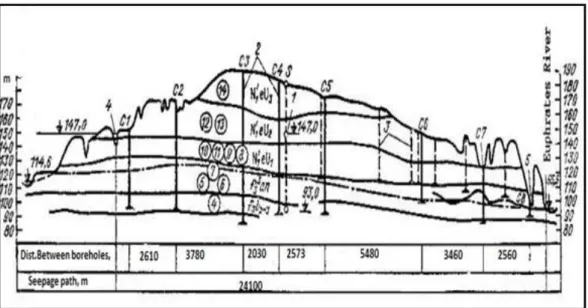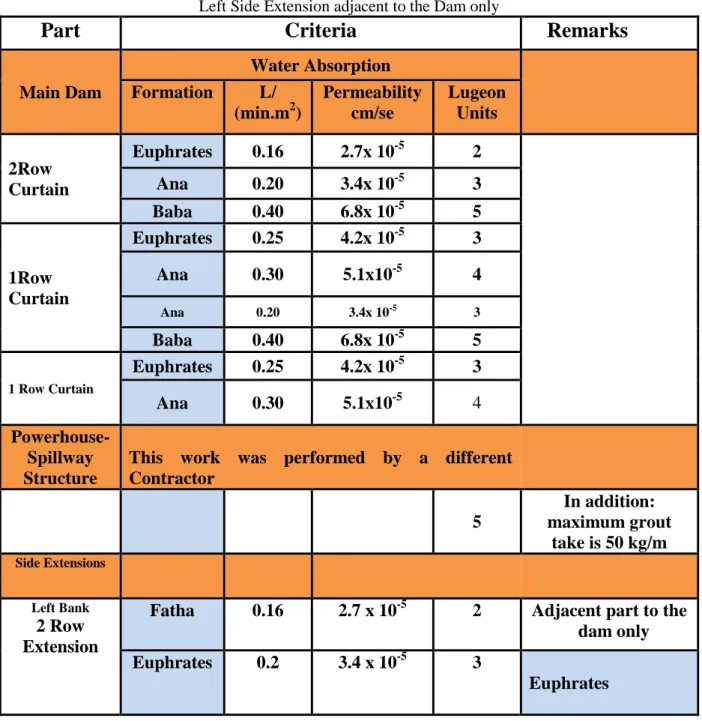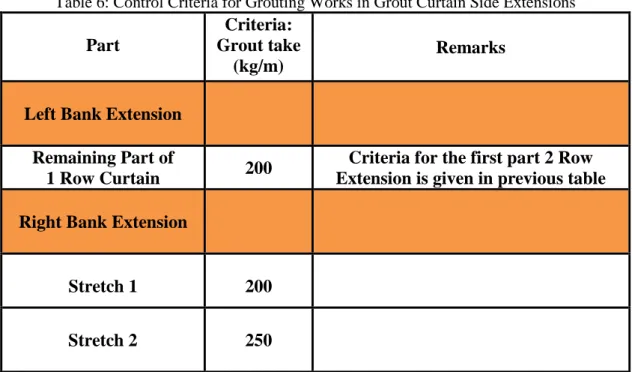Scienpress Ltd, 2018
Comparative Study of Mosul and Haditha Dams,
Iraq:
Foundation Treatments in the Two Dams
Nasrat Adamo1, Varoujan K. Sissakian2, Nadhir Al-Ansari1, Sven Knutsson1Jan Laue1 and Malik Elagely3
Abstract
Mosul and Haditha Dams are built on relatively weak foundations. Both of these foundations suffer from extensive karsts which had demanded intensive foundation treatment works among other design precautions. The karst forms; however, are of different origins, activities, nature and shapes. The foundation treatment in both dams was done mainly by constructing deep grout curtains along with other secondary grouting works. Reducing uplift pressure under the dam and cutting down on seepage losses were the major considerations in these works. An additional important requirement in Mosul Dam was to reduce the permeability of the rock formation in the foundations to such a low limit that it can stop the dissolution of gypsum beds present there. This objective; unfortunately, failed due to the lithological composition of this foundation and the presence of many brecciated gypsum beds, which could not be treated successfully. This had resulted in a comprehensive grouting maintenance program which continuous up to date with the everlasting danger of dam failure. On the other hand, in Haditha dam no such complication occurs as the dam had its foundations mainly in limestone. Proper investigation and good planning and performance of the grouting works in this dam contributed highly to its success. Selecting the deep grout curtain as anti-seepage measure in Mosul Dam was not a very wise decision and constructing a positive cutoff in the form of diaphragm wall could have been the proper choice. Good and deep understanding of all geological data can contribute to the success of a dam design or, otherwise it may lead to unsafe one.
1
Lulea University of Technology, Lulea, Sweden.
2 University of Kurdistan, Hewler, KRG, Iraq and Private Consultant Geologist, Erbil, Iraq. 3 Private consultant, Baghdad, Iraq.
Keywords: Mosul Dam, Haditha Dam, Karst, Sinkholes, Gypsum, Limestone, Grout curtain. Diaphragm
1 Introduction
Foundation treatment is an essential part in the design and construction of safe dams. Such treatment may take different types, shapes and methods. The objectives are always to reduce seepage through the foundation in order to reduce water losses for one reason; the other more important goals are to enhance the stability of the dam against uplift pressure and/or the washing away of the foundation materials. As all dam designers well know, these measures may vary between a host of possibilities; such as excavating cutoff trenches to reach competent foundation bedrock, execute blanket grouting that aims at creating a homogenous foundation which is less permeable and having higher bearing capacity, perform a deep cutoff which may be a grout curtain or a diaphragm wall. In important dams and in less than good foundation geology combination of some of these measures may be done. Drainage plays also an important role in uplift pressure relief on the downstream base of the dam, which could be in the form of horizontal drainage blankets or vertical relief wells depending on the actual foundation configurations. The geology of the foundation invariably plays the most important factor on deciding the method of treatment and its extent as far as the safety of the dam is concerned. In this paper we try to clarify this by presenting two cases: i.e. Mosul Dam and Haditha Dams foundation treatments. These are the largest two dams in Iraq, which control most of the water resources of the Tigris River, all the water resources of the Euphrates River as they flow into Iraq.
2 The Geological Factors
Mosul and Haditha Dams are both founded on rocks of sedimentary origins. Full description of the geology of the two sites are given in reference [1] which covers geomorphology, tectonics and structural geology, and stratigraphy at the two sites. The same paper concludes that the foundation geology at the two dam sites is quite different, but they share, however, one common phenomenon which prevails in the effective depth of their foundations; this is karstification. The karstification itself is quite different in the two sites in many ways, but at both sites this karstification is a very active process and it is still ongoing. Table (1) summaries and compares the main geological properties and conditions in the two sites.
Given the above geology in the two sites, the following paragraphs detail the foundation treatment in each of the two dams and our comments and conclusions
Table 1: Brief comparison between the main geological properties and conditions at both Mosul and Haditha Dam site [1]
Aspects Mosul Dam Haditha Dam Remarks
Tectonic And Structural Characters
Within the Low Folded Zone of the Outer Platform. The dam is located in the plunge of Butma East anticline.
Within the Inner Platform. The dam is located in an unfolded area; therefore, the beds are almost horizontal.
Both dams are located;
tectonically, within the Arabian Plate. Geomorphological
Aspects
Anticlinal ridges, karst forms, flat irons and intensive weathering
Residual soil, Karst forms, moderate to intensive weathering.
The only common feature is the karst forms.
Stratigraphy and Type of the rocks
The dam site is within the Fatha Formation, which consists of cyclic sediments, each cycle includes marl, limestone and gypsum.
The dam site is within the Euphrates Formation, which consists of basal
conglomerate, hard dolomite, chalky limestone and undulated limestone.
Both dams are located within sedimentary rocks sequence; almost all rocks are highly karstified.
Karstification
The main karst form is the sinkholes, majority of them are within the gypsum beds. The sinkholes are of solution type The thickness of the karstified sequence is about 300 m.
The main karst form is the sinkholes, majority of them are within the limestone beds. The sinkholes are of collapse type The thickness of the karstified sequence is about 50 m.
The karstification is an active process and still ongoing in both sites.
3 Foundation treatments of the two dams: Details
3.1. General Foundation treatment in the two dams consisted mainly of deep grout curtain
extending into the foundation under the whole length of the dam, and contact or blanket grouting under the core. In Mosul Dam, consolidation grouting was also used locally in the concrete structures foundations where needed to improve rock quality; as far as homogeneity was required, and to stop seepage water circulation in cracks and fissures within the rock mass [2]. In Haditha Dam, local grouting was additionally used for filling localized large cracks penetrating through bench (10) and bench (11) of the Lower Member of the Euphrates Formation between stat. 30+00 and sta. 31+00) [3]. In this dam, the drainage system consists of vertical relief wells installed to reduce excess uplift pressure in the downstream side of the dam base while a horizontal drainage layer was constructed at the downstream of Mosul Dam base. In each of the two dams the deep grout curtain was extended beyond the two ends of the main dam forming secondary curtains of shallower depths, which were meant to cut off any seepage path that may exist due to karstification of the geological formations and stop any underground flow from
As indicated in Table (1), karst forms are present in both sites, but they are of different, origin, activities, sizes and shapes. The foundation treatments at the two sites were different in as much as these karst forms and their depths had dictated, whether, in the design of these works or their extent, which is explained hereinafter.
3.2 Mosul Dam: Foundation Treatment
Grouting works in Mosul Dam were comprised of: three rows deep grout curtain under the main dam and its abutments, two rows deep grout curtain under the saddle dam and the grout curtain extensions in the left and right banks. Blanket grouting of twenty grout holes with depth varying between (10-25) meters was added under the clay core of the dam to enhance the properties of the rock mass as far as its bearing capacity is concerned, and to plug all seepage conduits, cracks and reduce its general permeability. Consolidation grouting was also used in the foundation of the concrete structures to improve the general properties of the foundation. The deep grout curtain was designed to: 1) reduce seepage through the foundations to safe limits, 2) enhance the dam’s stability by reducing uplift, 3) minimize the dissolution of the gypsum beds present within the Fatha Formation, and 4) stop the development of sinkholes in future, and to fill the already existent sinkholes and cavities at the depth of foundations. The maximum design depth of the curtain at the deepest point in the river channel was (80 – 100) m. This was based on the assumption that the bottom of the last brecciated gypsum bed (GB0) under the dam which is at this depth represents the deepest limits of the karstification in this foundation. This limit was defined by the designer with what was called “Karst Line” (Figure 1). This assumption proved to be wrong and the dissolution processes continued further down in depth during the operation of the dam as revealed during the maintenance grouting program which has continued from 1987 up to the present date. Figure (1) also shows the brecciated gypsum beds (GB0), (GB1) and (GB2) in their ascending order, the fourth one (GB3) does not appear in the figure as it approach the surface further to the left at the left bank under the chute of the service structure and the flip bucket at its end, and continues further under the saddle dam, which embody the emergency spillway structure. The design criteria of the curtain under the main dam, the saddle dam and in the left and right sides extensions were treated in details in a paper on the foundation treatment of the dam during construction [4] and they are summarised in Table(2)
Figure 1: Mosul Dam Designer’s visualization of the karst line in dam foundation [Note the existence of GB0 bellow the so called “Karst Line”
The criteria specified by the designer for the deep grout curtain were to aim at getting water tightness of 2 Lugeon at the upper part of the curtain and 5 Lugeon in the lower part of it. This could not be achieved due to the resistance of the brecciated gypsum beds (GB0, GB1, BB2, GB3) to the penetration of grouts and /or not being able to hold these grouts for a long time, in spite of using all possible combinations of grout mixes and grouting methods and procedures. To understand the behaviour of these brecciated gypsum beds one may refer to [5] to see how they start and develop. As dissolution is initiated within a cavity, joint or crack within a gypsum bed by seepage water the gradually increased flow invigorate further dissolution of gypsum and causes the enlargement of the cavities in different shapes and extents. In Mosul Dam, such dissolution in most cases starts within the interface of gypsum with the badly cracked and fissured marl and limestone beds and, furthermore clay filling is washed inside the cavity from the marly layers on top through the cracked and jointed limestone. The resulting breccias are a complex of gypsum fragments, anhydrite and limestone chips and blocks which are locked in fine clay matrix. Such structure did not respond to any type or procedure of grouting and when trials were partially successful, the brecciated gypsum beds could not hold on the grout and dissolution, piping and washing away of the filling material starts all over again (Figure 2). This type of karst may be considered as one of the worst types and should be avoided in hydraulic works if possible, or to avoid grouting it as an anti-seepage measure. Replacement of this material could be done if it is at the surface or at shallow depth, otherwise using positive cut-off such as slurry trenches or concrete diaphragm walls may provide the solution
Figure 2: Brecciated gypsum beds’ formation processes [5]
It is worth noting that one Lugeon unit is equal to a permeability of 1.3 x 10-5 cm/sec. All efforts to get a good curtain failed before impounding the reservoir and there were what was called “open windows” during the impounding and afterwards that resulted in a worsening situation leading to the intensive maintenance grouting program which is continuous up to the present date. During the filling and operation years, many sinkholes developed on the ground surface; first, at the right rim of the reservoir, and then followed by other sinkholes in the right bank, and later on in the left bank (Figure 3), shows the sinkhole at the left bank which appeared on 15th of February 2003.
Figure 3: The sinkhole on the left bank close to the downstream of the dam, appeared on
These sinkholes were all close to the downstream of the main dam. Sinkholes were discovered also afterwards in the floor of the reservoir very close to the dam during a bathymetric survey performed in 2013 [6], which showed the formation of numerous dissolution sinkholes, and indicating direct link between the reservoir and the ground water aquifer extending all around the dam and connecting to the downstream. In 2005, a Panel of Experts postulated in a study on Mosul Dam that this dam could fail due to karsts development in the form of sinkholes with limited or no warning time [7], [8]. In 2006, another Panel of Experts decided that the formation of these sinkholes represent such a hazard to the dam that it threatened it with immediate collapse and recommended in 2007 to reduce the maximum operation water level from design elevation 330.00 m (a.s.l.) to elevation 319.00 m (a.s.l.).
These findings were discussed in details in a recent paper [9] on the subject. The miss-interpretation of the geological data obtained during the investigations has led to misunderstanding of the nature and depth of the karsts phenomena in Mosul Dam foundation, which had caused the adoption of the wrong treatment. This conclusion was clearly spelt out in another paper recently published by the authors [10]. Our opinion is that a positive cut-off in the form of a concrete diaphragm wall should have been used instead of the deep grout curtain. The seepage and gypsum dissolution continues up to date, and in our final appraisal of the present safety condition of the dam we may borrow from the medical literature the term “Malignant” to describe the karst forms and their depths in Mosul Dam foundations in that it is most difficult to treat and cure and threatens the collapse of the dam.
3.3 Haditha Dam: Foundation Treatment
The geological conditions at Haditha Dam site and its surrounding played an important role in the design of the foundation treatment as one would expect. The geological formations here are older than those in Mosul dam, and the karst forms are of different origin. The karst forms, actually occur in the limestone of the Euphrates and Ana formations in Haditha Dam rather than gypsum beds and brecciated gypsum beds in the Fatha Formations and even in the Euphrates Formation below it in Mosul Dam. The foundation treatment in Haditha Dam consisted of a main deep grout curtain under the earth fill dam and power house- spillway combined structure, wing grout curtains at the right bank and left bank, in addition to filling grouting of large voids (fractures, caverns, karst cavities) with area grouting in limited zones of the central part of the dam foundation [3]. Vertical relief wells were installed at the downstream toe of the dam as part of the treatment to prevent building up of uplift pleasure on this side by drainage. The main grout curtain was performed between stations DM.5+75 and DM. 95+14 making its total length 8939 meters. The left bank extension was constructed between DM. 94+80 to DM. 131+ 00 (i.e. 3620 m long), while the right bank extension was done between DM. 0+00 to DM. 97+00 making its total length 9700 meters. The objectives of the main curtain under the dam and the powerhouse- spillway combined structure were to decrease seepage losses and provide seepage stability of the foundation, lower seepage line at the downstream side of the dam foundation and reduce uplift pressure. This was achieved jointly with drainage by using
vertical relief wells [11]. There was no question of severe dissolution in Haditha Dam foundations similar to the case in the foundations of Mosul Dam; this is attributed to the fact that the dissolution rate of the limestone is much lower than that of the gypsum prevailing in the Mosul Dam. Scientific literature indicates that solubility of gypsum at 20
C° is two orders of magnitude greater than the solubility of CaCO3, which is the major
mineral constituent of the limestone[12]
Under the main dam and power station- spillway structure, the curtain was constructed down to penetrate the Euphrates and Ana formations completely, and to (5 – 10) m deeper into the less karstified and less permeable rocks of the Baba Formation. The values of the coefficients of permabilities of the various formations are given in Table (3) in meters/ day listed from the surface downwards [3]. These values are converted in this paper to centimetres/ sec and shown in the same table. The depth of this curtain reached up to 100 m and generally corresponded to 1.5H (H is the dam height at the point under consideration). Normally, this rule of thumb is used often for small dams and when there are no geological problems within such depth, but generally speaking geological conditions are the governing factor in selecting the curtain depth in the case of difficult or troublesome geology. Figure (4) shows the lower limit of the deep grout curtain and the Formations it penetrates. It must be read in conjunction with Table (4) which gives the legend for these Formations and their description.
Table 3: Values of the Coefficients of Permeability of rock formations in Haditha Dam Foundations from top to bottom
Formation Permeability Coefficient m/day Permeability Coefficient cm/sec Remarks
Alluvial Deposits 0.5-50 6x10-4 - 6x10-2 Low to High
Lower Fars 1 0.2- 386 2.3x10-4 – 4.5x 10-1 Low to Very High
Lowe Fars 2 1.0- 5.0 1.2x10-3 – 6x10-3 Moderate
Upper Euphrates 0.5- 5.0 6x 10-4 – 6x10-3 Low to Moderate
Midde Euphrates 0.01- 0.4 1.2x10-5 - 4.7x 10-4 Very Low to Low
Lower Euphrates 0.3- 2.0 3.5x10-4- 2.3x 10-3 Low to Moderate
Ana in the river sec.
32.5 3.8x10-2 High
Ana at the abutments
0.01- 5.0 1.1x10-5- 6x10-3 Very Low to Moderate
Lower Baba < 0.01 < 1.2x10-5 Very low
Figure 4: Geological cross section under the dam and Powerhouse- Spillway Structure, showing the lower limits of the grout curtain
Table 4: Simplified lithological column in Haditha Dam site
No Symbol Formation Description
8
N22f2 Fatha
Alternation of green marl, limestone and gypsum and red claystone appears in the upper half part 7 N22f1
Euphrates
Undulated limestone, very hard, thinly well bedded 6
N21eu3 Brecciated marly and dolomitic limestone, highly
deformed and undulated, with lenses of green marl. 5
N21eu2
Chalky dolomitic limestone, massive in the lower part well bedded in the upper part. About 90% of the apertures sinkholes are developed in thus unit, which
forms the flat plains in Haqlaniyah, Hadithah, Anah until Al-Qaim
4
N21eu1
Basal conglomerate (The main reason for karstification), overlain by well bedded very hard
limestone 3
P21an Ana
Massive and cavernous limestone, very hard, silicified and splintery
2 P11 b2
Baba Massive dolomitic and marly limestone with
Lepidocyclina traces fossils. 1 P11b1
The Soviet geologists considered units Nos.7 and 8 as the Fatha Formation in accordance with the Geological Survey of Iraq (1974), but latter on the Geological
Survey of Iraq merged it with the Euphrates Formation. The main curtain from DM DM 5+ 75 to DM 77+75 was made of two rows of grouting holes with a distance of of 1.5 m between rows and 3 m spacing between holes arranged in staggered fashion. From DM 77+75 to DM 95+14.5 the main grout curtain and the left and right grout curtain extensions were made of single row of grouting holes with 3 m spacing. The top of the main curtain was linked with the base of the dam by means of a surcharge concrete slab (0.7 – 1.0) m thick strengthened by concrete cut-off (3 – – 5) m deep between DM 5+100 to DM 34+60 and DM 45+00 to DM 55+80. The width of the surcharge slab was 12 m in the channel section and floodplain parts of of the dam and (6 – 8) m in its banks extensions. The upper part of the curtain was widened by contact blanket grouting. The number of rows of this grouting in the channel section and flood plain parts varied between (6 – 8) rows but the number was reduced to (2 – 4) rows in the banks extensions and the depth of the blanket varied between (5 – 12) m.
The side extensions of the curtain at the two banks were designed to stop the possible concentrated seepage flows along large fissures and karstic zones in order to reduce seepage losses, and eliminate the possibility of piping and washing away of the fine material filling the karst network of conduits and cavities, which could be caused by the increase of hydrostatic pressure when the reservoir is filled
In both banks, the curtain extensions were made shallower than the main grout curtain; at the end of the right bank curtain it goes down to intersect the zone of the karstified limestone beds in the Ana Formation. The left bank curtain extension stretches down only to intersect the most permeable layer of the limestone in the Euphrates Formation and penetrates (5 – 10) m deeper than the natural ground water level [13], besides, the treatment was below 147 m (a.s.l.), which is the Maximum Operation water level.
The engineering-geological conditions in the region of the right abutment side curtain are characterized by almost horizontal occurrence of various sedimentary rocks of mainly low permeability. They belong to the Upper and Lower Members of the Euphrates Formation, which overlies on cavernous high permeability limestone of the Ana Formation. Anna Formation; however, in turn overlies the impermeable limestone of the Baba Formation. At this bank it was necessary to seal the Ana Formation which dominated the depth of the curtain,
reaching 85 m near the dam and 41 m at the end of the curtain. The right bank curtain extension itself was completed in two stages.
The first stage closest to the dam was only 4000 m and it was completed in 1986. The other 6260 m was completed later on after conducting additional geological investigation due to the observation of the presence of large number of sinkholes and karst cavities at that area. This investigation concentrated on a possible seepage flow between the wadi Al-Akhdar then through Wadi Tanayah, a tributary of Wadi Haglan and ending in wadi Haglan itself; very close to its confluence with the Euphrates River. Figure (5) shows the layout of all parts of the curtain and shows also the investigated line of concentrated karst forms with boreholes’ locations.
The longitudinal section along the line of exploration (Fig.6) shows the investigation boreholes’ locations and indicates that their depths extend below the expected seepage line between the reservoir water level of 147 m (a.s.l.) to the Euphrates River through wadi Al-Akhdar, wadi Tanayah and wadi Haglan.
In Haditha Dam site, the geological investigation took very long time to complete, but it was done in a very careful manner; moreover, this work did not have a target time to finish as long as new findings were discovered. This manner allowed the intensification of the work whenever encountering a specific important problem. The designers showed full understanding of the nature of the foundations and put special care on any uncovered anomaly. The investigation was not limited to the site itself; but extended to large area around it. The karst phenomena were also handled with care and understanding whether, in the site itself, or around it. The grouting works took into consideration the results of these investigations in every detail. These endeavours resulted in a good overall design and a stable dam, which has not shown so far any serious defect or miss functioning. In Haditha Dam, there were two aspects; the first dedicated to the curtain grouting under the main dam and the second dedicated to the wing curtain grouting as well.
The control criteria of the completed work were set to satisfy the specified requirement in the design: that is reduction of uplift pressure and seepage quantities under the dam itself, while it aimed at blocking karst cavities and larger fissures in the side curtains. With consideration of the fact that the grouting holes of the planned side curtains intersect the same members of fine-fissured and macro-porous dolomites, so the indicator of the quality of the finished curtain is the absence in the grouted zone of large open fissures and karst cavities. It followed that the grout take per one meter of the grout hole in the side curtains would give a better indication of the grouting quality than would water absorption. Table (5) and Table (6) summarize the criteria under consideration in both the Main dam, Powerhouse -Spillway structure and side curtains on both banks. The water absorption units used by Soviet engineers were given in liter / m.m2 [13]; in this paper, these values are also shown in the same table in permeability units (cm /sec) and in Lugeon units for illustration and comparison with Mosul Dam grouting criteria.
Figure 5: Plan showing the Grout Curtain Extensions
Table 5: Control Criteria for Grouting work under Haditha Dam the Main Dam and the Left Side Extension adjacent to the Dam only
Part
Criteria
Remarks
Main Dam Water Absorption Formation L/ (min.m2) Permeability cm/se Lugeon Units 2Row Curtain Euphrates 0.16 2.7x 10-5 2 Ana 0.20 3.4x 10-5 3 Baba 0.40 6.8x 10-5 5 1Row Curtain Euphrates 0.25 4.2x 10-5 3 Ana 0.30 5.1x10-5 4 Ana 0.20 3.4x 10-5 3 Baba 0.40 6.8x 10-5 5 1 Row Curtain Euphrates 0.25 4.2x 10-5 3 Ana 0.30 5.1x10-5 4 Powerhouse- Spillway Structure This work was performed by a different
Contractor 5 In addition: maximum grout take is 50 kg/m Side Extensions Left Bank 2 Row Extension
Fatha 0.16 2.7 x 10-5 2 Adjacent part to the
dam only
Euphrates 0.2 3.4 x 10-5 3
Euphrates
The right bank extension and the remaining part of the left side extension are checked according to the following values in Table (6), as can be seen, these are given in terms of grout take in kilograms per meter of the grouted interval.
Table 6: Control Criteria for Grouting Works in Grout Curtain Side Extensions Part Criteria: Grout take (kg/m) Remarks
Left Bank Extension
Remaining Part of
1 Row Curtain 200
Criteria for the first part 2 Row Extension is given in previous table
Right Bank Extension
Stretch 1 200
Stretch 2 250
3.4 Summarized Comparison
In summary and comparison; the foundation treatment in each of Mosul and Haditha Dams consisted mainly of deep grout curtain extending into the foundation under the whole length of the dam, and contact blanket grouting under the core. In Mosul Dam, consolidation grouting was also used locally in the concrete structures foundations where needed to improve rock quality; as far as homogeneity was required, and to stop seepage water circulation in cracks and fissures within the rock mass. In Haditha Dam, apart from the deep grout curtain blanket; grouting was also performed at the top of the deep grout curtain, which consisted of variable number of rows and depths depending on the particular location along the dam. Local grouting was additionally used for filling localized large karstified cracks penetrating through bench (10) and bench (11) of the Lower Member of the Euphrates Formation between station DM 30+00 and station DM 31+00 [3]. In this dam, drainage system of vertical relief wells was also installed to reduce excess uplift pressure in the downstream side of the dam base. In installing these relief wells there was no fear of any dissolution of foundation material as these were mainly of limestone. Such an arrangement cannot be made in Mosul Dam; as more drainage means increased dissolution of the gypsum present there. The deep grout curtain in Mosul Dam was not successful in reducing the seepage to the limits necessary to stop the dissolution of the gypsum present in the foundations.
In each of the two dams, the deep grout curtain was extended beyond the two ends of the main dam forming secondary curtains of shallower depths.
These were required to cut off any seepage path that may exists due to the karstification of the geological formations and stop any underground flow from outflanking the main dam and finds its way back to the river channel.
In Mosul Dam, the left side extension has not been successful in sealing the foundation to the required level in spite of additional works that consisted of performing a second row of grouting holes to the original single row and also deepening the whole curtain. Seepage and dissolution of the gypsum beds continues up to now. It is a proven fact now that this seepage had contributed to the formation of the two sinkholes, which appeared at this bank close to the dam. More of such sinkholes are expected and this was one of the reasons to lower the maximum operation water level of the reservoir from 330 m (a.s.l.) to 319 m (a.s.l.)
in 2006.
4 Conclusions
4.1. The foundation geology of any dam plays the most important role in the selection of the type and details of foundations’ treatments. While both Mosul and Haditha Dams sites suffered from the presence of karsts; these karsts were of different origins, types, shapes, sizes and depths. In Mosul Dam site, it was of dissolution type, which was formed as a result of the high dissolution rates of gypsum beds within the foundations. In Haditha Dam site, it occurred in varying degrees in the limestone beds of the Euphrates and Ana formations in the shape of fissures, cracks and nearly isolated collapsed sinkholes. Sinkholes in Mosul Dam site are of the dangerous dissolution type which could develop quickly and appear suddenly without enough prior notice but, sinkholes in Haditha Dam site are not the same as they are of the collapse and stable closed type and they take very long time to develop which make them less dangerous. This is attributed to the fact that limestone is generally less soluble than gypsum. In both cases, deep grout curtain was implemented, but with different degrees of success. The deep grout curtain in Mosul Dam was not able to lower the permeability and reduce seepage quantities to the specified amounts compatible with the dissolution properties of gypsum rock and anhydrites, in addition the specific nature of the brecciated gypsum beds present there made such work extremely difficult and not fruitful in most cases. These beds dominated four levels of the foundations and they played a very negative role due to their peculiar nature of not being able to hold permanently the grouting materials. The end result was an inefficient curtain, which has led to the intensive maintenance grouting program that continues up to date with the constant hazard of dam failure and collapse.
In Haditha Dam, the curtain was required to seal the cracks and fissures and fill the sinkholes to get a reasonably tight foundation to reduce seepage seepage losses to lesser quantities, and to reduce uplift pressure on the downstream downstream side of the dam base, the depth and width and intensity of grouting
holes were all tailored to the specific needs of all the finite reaches along the dam foundation. This was only possible as a result from the intensive and careful geological investigation works which were carried out ahead of the grouting and were repeated whenever there was doubt or an anomaly. Drainage of the under layers of the foundation was made by installing relief wells, which were drilled at the downstream toe of the dam. Generally speaking, the whole treatment was correctly designed and properly constructed and accomplished its required objectives.
4.2. The thickness of the karstified rocks in Mosul Dam site is about 300 m, whereas at Haditha Dam site is about 50 m. This large difference in the thickness of the karstified succession of rocks played also a big role in causing more difficulties in the grouting process in Mosul Dam. Moreover, in Mosul Dam site, the rocks are tilted and deformed due tectonic activities, which had increased the dissolution ability, whereas in Haditha Dam site, the beds are almost horizontal and not deformed; as they are not affected appreciably by tectonic forces.
4.3. In reflecting on the design decisions taken during planning and design stage and final performance of the foundation treatments in both dams, it can be seen how human errors of judgment can play a significant role in the success or failure of Engineering Works. Failing to understand the nature of the foundation geology and misinterpreting the investigation data led to the adoption of the wrong anti-seepage method in Mosul Dam. One alternative to the grout curtain could have been the construction of a positive cut-off in the form of a diaphragm wall. At the time of Mosul Dam construction technological possibilities were available to construct such a diaphragm from the top surface of the foundation which would have been of much shorter depth than if it is attempted as would today from the dam crest, but it would have meant extending the completion period by another year. We are sure that such extension of time would have been acceptable by everyone including the owner, have they known the consequences of failing to take such a decision at that time. In Haditha Dam, although the nature of the foundation was simpler, very comprehensive geological investigations were still needed and were done with precision and utmost care; moreover, the understanding and interpretation of these data were correct and successful. This had led to the proper foundation treatment and getting a stable dam in the end and stable dam.
References
[1] Sissakian, V., Adamo, N., Al-Ansari, N., Kn utsson, S.;Laue, J. and Elagely, M.,2018,. 2018, A Comparative Study of Mosul and Haditha Dams, Iraq:
Geological Conditions, Journal Earth Sciences and Geotechnical Engineering, 8,2,34-49.
[2] Swiss Consultant Consortium, “Mosul Dam, Final Report”. 1989
[3] Salem A., 1985, “Foundation Treatment. Problems Encountered in the Construction of Haditha Dam”. Proceedings of the 15th ICOLD Congress, Q58, R20, Lausanne 1985
[4] Adamo N, Al-Ansari N, Issa, E, Sissakian V, Knutsson S., 2015, “Mystery of Mosul Dam the most Dangerous Dam in the World: Foundation Treatment during Construction”. Journal of Earth Science and Geotechnical Engineering, 5, 3, 59-69
[5] Warren, J. K. 2006. Evaporites: Sediments, resources and hydrocarbons. New
York: Springer-Verlag [6] Issa E, Al Ansari N, Knutsson S., 2013,” Changes in bed Morphology of
Mosul Dam Reservoir”. Journal of Advanced Science and Engineering
Research, 3, 2, 86-95.
https://www.diva-portal.org/smash/get/diva2:981210/FULLTEXT01.pdf [7] Washington Group international & Black and Veatch, 2005, “Mosul Dam
Study. Final Report. Task order no 8, Project”. Contracting office, Provisional
Coalition Authority, Baghdad Aug 2005 [8] Adamo N, Al-Ansari N., 2016, “Mosul Dam the Full Story: Safety Evaluations
of Mosul Dam”. Journal of Earth Science and Geotechnical Engineering, 6, 3, 185-212
[9] Adamo N, Al-Ansari N, Laue J, Knutsson S, Sissakian V., 2017, “Risk Management Concepts in Dam Safety Evaluation: Mosul dam as a Case study”. Journal of Civil engineering and architecture 11, 635-652 doi: 10 17265/ 1934-7359/2017.07.007 David Publishers.
[10] Sissakian V, Adamo N, Al-Ansari N, Knutsson S, Laue J. ,2017, “Defects in Foundation Design Due to Miss-Interpretation of the Geological Data: A case
Study of Mosul Dam” , Engineering, 9, 7,683-702. [11] Dmitriev N, Malyshev L., 1983, “Grouting Works in the Foundation of the
Dam of the Al-Haditha Hydroproject Development on the Euphrates River in Iraq”. (In Russian) translated to English from Gidrotekhnicheskoe Stroitel’stvo, No. 10, p. 41-47, October 1983. Available on the following link
(restricted access)
https://link.springer.com/article/10.1007/BF01425185
[12] Kimchouk A. 1996, “Dissolution and Conversion of Gypsum and Anhydrite”.
Inter. J Speleol. 25(3-4) Chapter 12 pp 21-36
http://scholarcommons.usf.edu/cgi/viewcontent.cgi?article=1306&context=ij s
[13] Ashikhmen V, Buchatskii V, Dmitriev N.1989, “Grouting Works in the Side Grout Curtains of the Al-Qadisiyah (Haditha) Hydro Development (IRAQ). (In Russian) translated to English from Gidrotekhnicheskoe Stroitel’stvo, No. 1, pp. 45-50, January, 1989. Available on the following link (restricted access) https://link.springer.com/article/10.1007/BF0143319.
![Table 1: Brief comparison between the main geological properties and conditions at both Mosul and Haditha Dam site [1]](https://thumb-eu.123doks.com/thumbv2/5dokorg/4427144.106518/3.813.114.748.142.527/table-brief-comparison-geological-properties-conditions-mosul-haditha.webp)
